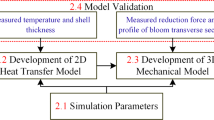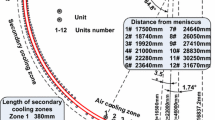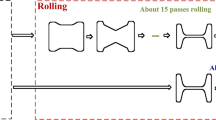Abstract
Some heavy reduction technologies near the solidification end have been gradually applied to casting slabs or blooms in recent years to eliminate internal shrinkage cavities. These technologies can be roughly classified as single-pass reduction type and multi-pass reduction type. To date, the conclusions about the influence of reduction type on void closure are inconsistent. Herein, based on the simulation experiments, the influence of the reduction type on the closure of the shrinkage cavity in bloom during hot-core heavy reduction rolling (HHR2) was investigated with the physical metallurgical model and numerical simulation. HHR2 processes with single-pass type and double-pass type were designed to evaluate void closure behavior, and the total reduction amount of different reduction types was 60 mm in both cases. Results show that the single-pass reduction type of HHR2 is more beneficial to the closure of the shrinkage cavity in bloom than the double-pass reduction type. Furthermore, the difference between the two reduction types was pointed out, which mainly includes three aspects: the geometry of the deformation zone, inter-pass static recrystallization and temperature of bloom. Finally, a quantitative analysis of the effect of the three abovementioned factors on void closure was performed. The obtained results show that the geometry of the deformation zone is the main factor, which leads to different degrees of void closure in different reduction types.





















Similar content being viewed by others
References
M. Kawaberi, Y. Yamamoto, and K. Asoh, Improvement of Properties of Rods and Bars by Continuous Forging Process, Int. J. Fatigue, 1995, 26(1), p 26–32. https://doi.org/10.1016/0142-1123(95)95897-P
M. Kawamoto and T. Nagira, 我が国における鋼の連続鋳造プロセスの開花と未来へのシーズ(Flowering of Continuous Casting Process for Steel in Japan and New Fundamental Seeds to the Future), Tetsu to Hagane, 2014, 100(4), p 472–484. https://doi.org/10.2355/tetsutohagane.100.472. (in Japanese)
C.H. Yim, Y.M. Won, J.K. Park, and S.H. Kwon, Continuous Cast Slab and Method for Manufacturing the Same, US Patent, No. US8245760B2, 2012
C. Ji, C. Wu, and M. Zhu, Thermo-Mechanical Behavior of the Continuous Casting Bloom in the Heavy Reduction Process, JOM, 2016, 68(12), p 3107–3115. https://doi.org/10.1007/s11837-016-2041-8
Y. Lu, L.N. Bartlett, and R.J. O’Malley, A Review on Hot Tearing of Steels, Int. J. Metalcast., 2021, 16, p 45–61. https://doi.org/10.1007/s40962-021-00599-3
H. Li, T. Li, R. Li, M. Gong, Z. Wang, and G. Wang, Effect of a Novel Hot-Core Heavy Reduction Rolling Process after Complete Solidification on Deformation and Microstructure of Casting Steel, ISIJ Int., 2019, 59(12), p 2283–2293. https://doi.org/10.2355/isijinternational.ISIJINT-2019-125
T. Li, H. Li, R. Li, Z. Wang, and G. Wang, Work Roll Surface Profile Design and Optimization for Hot-Core Heavy Reduction Rolling Process, ISIJ Int., 2019, 59(7), p 1314–1322. https://doi.org/10.2355/isijinternational.ISIJINT-2018-809
J.M. Llanos, V. Santisteban, and J. Demurger, Improvement of Central Soundness in Long Products from a Through Process Control of Solidification and Reheating and Rolling Parameters, Office for Official Publications of the European Communities, 2008, p 17–34. https://doi.org/10.2777/12946
X. Zhao, J. Zhang, S. Lei, and Y. Wang, Finite-Element Analysis of Porosity Closure by Heavy Reduction Process Combined with Ultra-Heavy Plates Rolling, Steel Res. Int., 2014, 85(11), p 1533–1543. https://doi.org/10.1002/srin.201300481
Q. Dong, J. Zhang, B. Wang, and X. Zhao, Shrinkage Porosity and Its Alleviation by Heavy Reduction in Continuously Cast Strand, J. Mater. Process. Technol., 2016, 238, p 81–88. https://doi.org/10.1007/s11837-016-2041-8
R. Cheng, J. Zhang, L. Zhang, and H. Ma, Comparison of Porosity Alleviation with the Multi-roll and Single-Roll Reduction Modes During Continuous Casting, J. Mater. Process. Technol., 2019, 6, p 96–104. https://doi.org/10.1016/j.jmatprotec.2018.10.033
R. Li, H. Li, T. Li, S. Li, and Z. Guo, 连铸坯热芯大压下技术轧制规程实验研究(Experimental Research on Rolling Procedure of Hot-Core Heavy Reduction Rolling Tech for Continuous Casting Billet), Proceedings of the 12th CSM Steel Congressed, Oct 15, 2019 (Beijing), The Chinese Society for Metals, 2019, p 418–423. https://doi.org/10.26914/c.cnkihy.2019.060746 (in Chinese)
C. Feng, Z. Cui, M. Liu, X. Shang, D. Sui, and J. Liu, Investigation on the Void Closure Efficiency in Cogging Processes of the Large Ingot by using a 3-D Void Evolution Model, J. Mater. Process. Technol., 2016, 237, p 371–385. https://doi.org/10.1016/j.jmatprotec.2016.06.030
C. Ji, Z. Wang, C. Wu, and M. Zhu, Constitutive Modeling of the Flow Stress of GCr15 Continuous Casting Bloom in the Heavy Reduction Process, Metall. Mater. Trans. B, 2018, 49(2), p 767–782. https://doi.org/10.1007/s11663-018-1188-9
F.J. Zerilli and R.W. Armstrong, Dislocation-Mechanics-Based Constitutive Relations for Material Dynamics Calculations, J. Appl. Phys., 1987, 61(5), p 1816–1825. https://doi.org/10.1063/1.338024
C.M. Sellars, Hot Working and Forming Process, Metal Society, London, 1980.
G. Li, T. Maccagno, D. Bai, and J. Jonas, Effect of Initial Grain Size on the Static Recrystallization Kinetics of Nb Microalloyed Steels, ISIJ Int., 1996, 36(12), p 1479–1485. https://doi.org/10.2355/isijinternational.36.1479
S. Medina and J. Mancilla, Static Recrystallization Modelling of Hot Deformed Steels Containing Several Alloying Elements, ISIJ Int., 1996, 36(8), p 1070–1076. https://doi.org/10.2355/isijinternational.36.1070
M. Nakasaki, I. Takasu, and H. Utsunomiya, Application of Hydrostatic Integration Parameter for Free-Forging and Rolling, J. Mater. Process. Technol., 2006, 177(1–3), p 521–524. https://doi.org/10.1016/j.jmatprotec.2006.04.102
M. Saby, P.O. Bouchard, and M. Bernacki, Void Closure Criteria for Hot Metal Forming: A Review, J. Manuf. Processes, 2015, 19, p 239–250. https://doi.org/10.1016/j.jmapro.2014.05.006
B. Wang, J. Zhang, C. Xiao, W. Song, and S. Wang, Analysis of the Evolution Behavior of Voids During the Hot Rolling Process of Medium Plates, J. Mater. Process. Technol., 2015, 221, p 121–127. https://doi.org/10.1016/j.jmatprotec.2015.02.012
C. Wu, C. Ji, and M. Zhu, Deformation Behavior of Internal Porosity in Continuous Casting Wide-Thick Slab During Heavy Reduction, Metals (Basel, Switz.), 2019, 9(2), p 128. https://doi.org/10.3390/met9020128
K. Chen, K. Liu, H. Chen, and Y. Yang, A Criterion for Void Closure in the Porous Model During the Forging of Steel Ingot and Its Application, Comput. Mater. Sci., 2014, 91, p 303–309. https://doi.org/10.1016/j.commatsci.2014.04.056
M. Tanaka, S. Ono, and M. Tsuneno, Factors Contributing to Crushing of Voids During Forging, J. Jpn. Soc. Technol. Plast., 1986, 27(306), p 927–934.
H. Kakimoto, T. Arikawa, Y. Takahashi, T. Tanaka, and Y. Imaida, Development of Forging Process Design to Close Internal Voids, J. Mater. Process. Technol., 2010, 210(3), p 415–422. https://doi.org/10.1016/j.jmatprotec.2009.09.022
M.-S. Chen and Y.C. Lin, Numerical Simulation and Experimental Verification of Void Evolution Inside Large Forgings During Hot Working, Int. J. Plast., 2013, 49, p 53–70. https://doi.org/10.1016/j.ijplas.2013.02.017
C. Feng, Z. Cui, X. Shang, and M. Liu, An Evolution Model for Elliptic-Cylindrical Void in Viscous Materials Considering the Evolvements of Void Shape and Orientation, Mech. Mater., 2017, 112, p 101–113. https://doi.org/10.1016/j.mechmat.2017.06.002
X. Wang and X. Dong, A Void Evolution Model Accounting for Stress Triaxiality, Lode Parameter and Effective Strain for Hot Metal Forming, Int. J. Mech. Sci., 2020, 168, p 105309. https://doi.org/10.1016/j.ijmecsci.2019.105309
F. Zhang and J. Yang, 连续铸钢 Contionous Casting Steel, 1st ed., Chemical Industry Press, Beijing, 2013, p 50–78 (in Chinese)
T. Wang, H. Di, X. Zhao, X. Gao, D. Zhang, and D. Wu, 现代轧钢学 Modern Steel Rolling, Metallurgical Industry Press, Beijing, 2014, p 50–54 (in Chinese)
S. Li, M. Sun, H. Liu, and D. Li, 25Cr2Ni4MoV钢锻造过程孔洞缺陷愈合规律研究 Study on Void Healing Behavior During Forging Process for 25Cr2Ni4MoV Steel, Acta Metall. Sin. (Chin. Ed.), 2011, 47(07), p 946–953. https://doi.org/10.3724/SP.J.1037.2011.00157 (in Chinese)
R. Li, H. Li, X. Ning, T. Li, H. Wei, and G. Wang, Temperature Influence on Section Uniformity of Casting Steel Rolled with the Hot-Core Heavy Reduction Rolling Process and Traditional Hot Rolling Process, J. Mater. Eng. Perform., 2022, 31(9), p 7391–7401. https://doi.org/10.1007/s11665-022-06776-7
Acknowledgments
This research is supported by the National Key Research and Development Program of China (No. 2017YFB0304603).
Author information
Authors and Affiliations
Corresponding author
Additional information
Publisher's Note
Springer Nature remains neutral with regard to jurisdictional claims in published maps and institutional affiliations.
Rights and permissions
Springer Nature or its licensor (e.g. a society or other partner) holds exclusive rights to this article under a publishing agreement with the author(s) or other rightsholder(s); author self-archiving of the accepted manuscript version of this article is solely governed by the terms of such publishing agreement and applicable law.
About this article
Cite this article
Ning, X., Li, H., Xiang, N. et al. Effect of Rolling Pass on Porosity Void Closure of Bloom during Hot-Core Heavy Reduction Rolling. J. of Materi Eng and Perform (2023). https://doi.org/10.1007/s11665-023-08383-6
Received:
Revised:
Accepted:
Published:
DOI: https://doi.org/10.1007/s11665-023-08383-6




